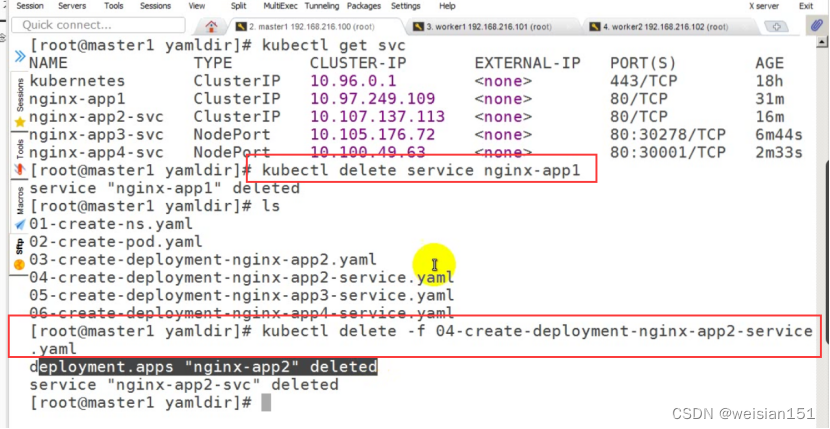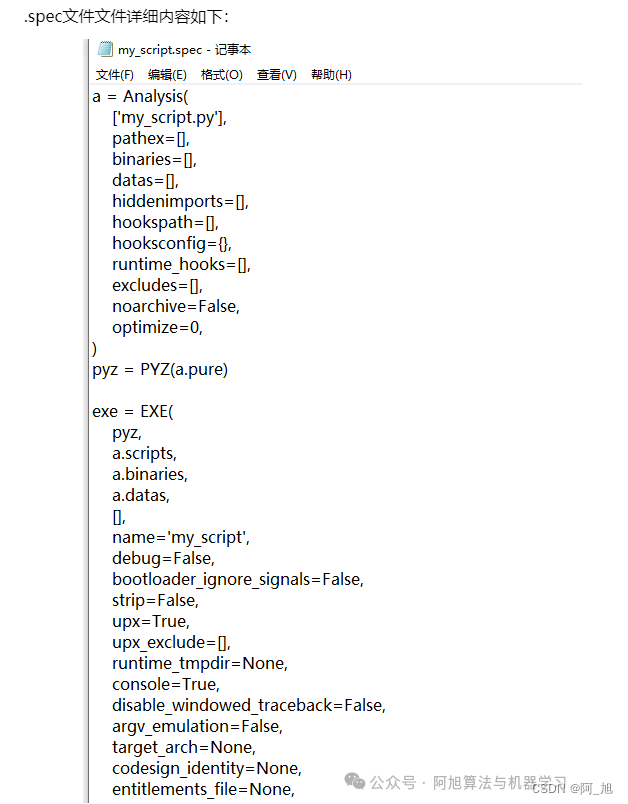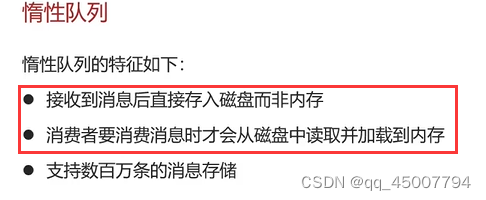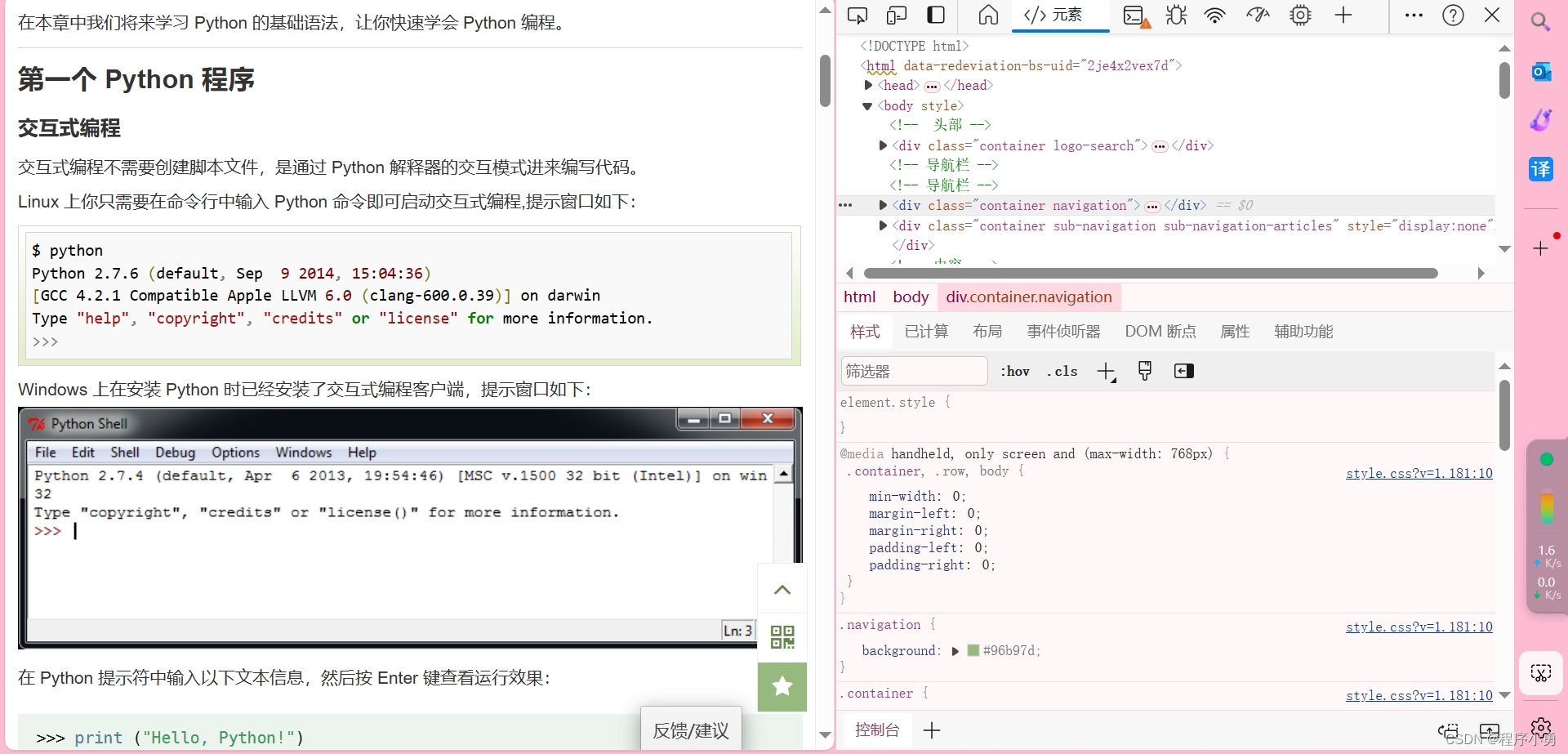重载的概念
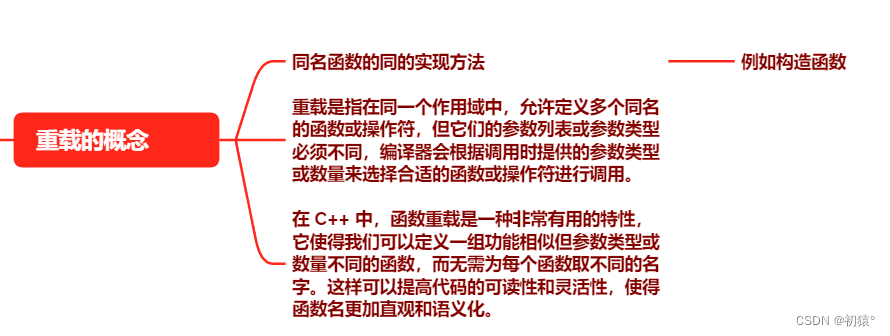
一.函数重载
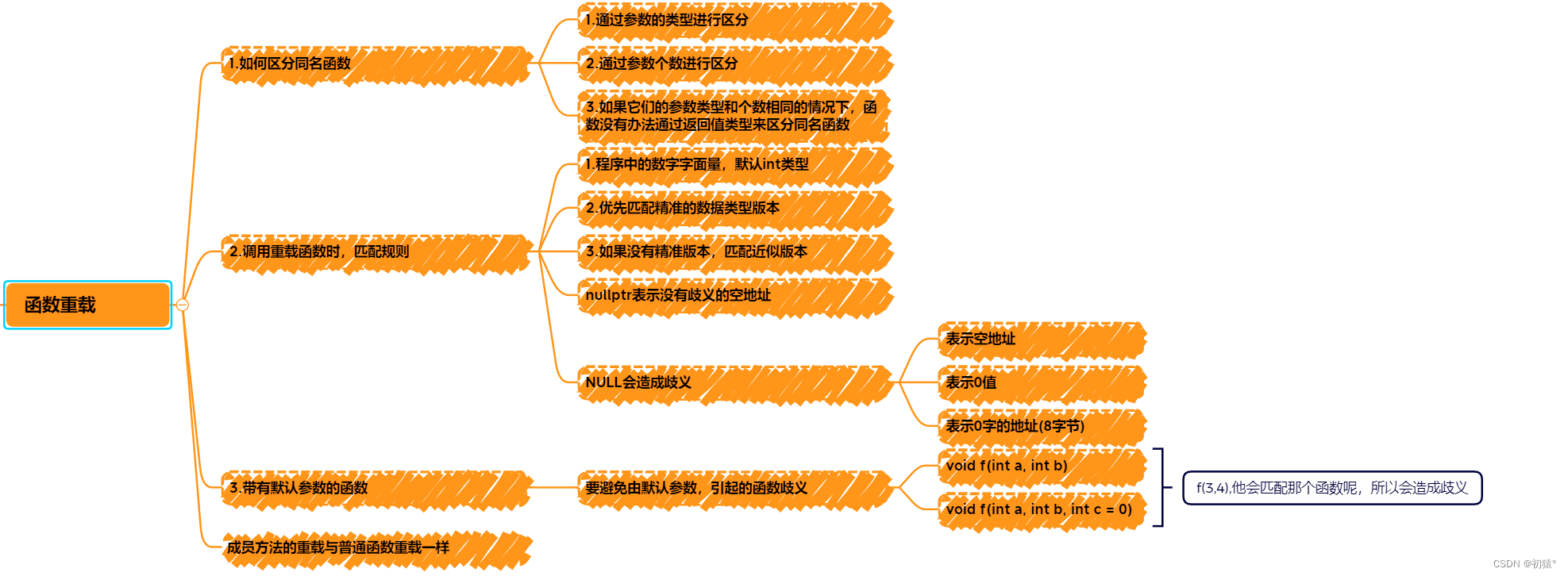
代码演示例子:
#include<iostream>
using namespace std;
//函数名相同,在是每个函数的参数不相同
void output(int x) {
printf("output int : %d\n", x);
return ;
}
void output(long long x) {
printf("output long long : %llX\n", x);
return ;
}
void output(const char *s) {
if (!s) {
printf("output string : nullptr\n");
return ;
}
printf("output string : %s\n", s);
return ;
}
void output(int x, int y) {
printf("output double int : %d, %d\n", x, y);
return ;
}
//如果调用这个函数时,没有传入参数3,也就是c
//那么c的默认值就为123,并且程序不会编译不通过
void output(int a, char b, int c = 123) {
printf("output a = %d, b = %c, c = %d\n", a, b, c);
return ;
}
//如果这里没有第三个参数,那么就会造成编译报错
//因为没有办法通过返回值类型进行区分重载类型
//也就是没有办法区分和上面的double int进行区分
const char *output(int a, int b, char c) {
printf("output a = %d, b = %d, c = %c\n", a, b, c);
return "yes";
}
int main() {
output(3);//这里匹配的是int类型的output
//在数字后面加上LL 表示这个数字是longlong类型
output(3LL);//这里匹配的是longlong类型的output
output("hello world");//匹配参数为char *的output
output(3, 4);//匹配参数为两个int类型的output
output(3LL, 4);//近似匹配了两个int类型的output
//下面这个output(NULL),他会匹配到int类型
//NULL可以表示成0值
//然后它也可以表示成一个地址,然后它又是0值的地址,地址有64位也就是8字节,那他也会匹配long long类型
//然后还表示一个空地址,还会匹配到char *类型
//output(NULL);
//而在C++中 nullptr只表示空地址,这样他就会精确匹配对应的函数
output(nullptr);
output(12, 'p');
cout << output(3, 4, 'c') << endl;
return 0;
}然后如果output(NULL)那行代码没有注释掉,那么就会出现,注释说明的情况,无法匹配造成歧义:
 对于成员函数重载和普通函数的重载一样,我就不用代码进行演示了。
对于成员函数重载和普通函数的重载一样,我就不用代码进行演示了。
二.运算符重载
不能重载的运算符:

类外:

参考代码:
#include <iostream>
#include <cstdio>
using namespace std;
class Point {
public :
Point() : x(0), y(0), output_width(0) {}
Point(int x, int y) : x(x), y(y), output_width(0) {}
private :
int x, y;
int output_width;
//利用友元进行解决私有成员属性的访问问题
friend ostream &operator<<(ostream &out, const Point &p);
friend int operator*(const Point &, const Point &);
friend Point operator+(const Point &, int );
friend double operator*(const Point &, double );
friend double operator*(double , const Point &);
friend Point &operator-(Point &, int x) ;
friend Point &operator-(Point &, Point &) ;
friend Point &operator-(Point &, const char *) ;
};
//ostream类型就像cout的对象的类型
//加上const为了同时支持const和非const限定的对象
ostream &operator<<(ostream &out, const Point &p) {
out << "(" << p.x << ", " << p.y << ")";
return out;
}
int operator*(const Point &p1, const Point &p2) {
return p1.x * p2.x + p1.y * p2.y;
}
Point operator+(const Point &p1, int x) {
Point p(p1.x + x, p1.y + x);
return p;
}
double operator*(const Point &p1, double x) {
return p1.x * x + p1.y * x;
}
double operator*(double x, const Point &p1) {
//这里他调用的就是上面运算符重载的方法
return p1 * x;
}
Point &operator-(Point &p, int x) {
p.output_width = x;
return p;
}
Point &operator-(Point &p1, Point &p2) {
char str[100] = {0};
snprintf(str, 99, "(%%%dd, %%%dd)", p1.output_width, p1.output_width);
printf(str, p2.x, p2.y);
return p1;
}
Point &operator-(Point &p, const char *s) {
printf("%s", s);
return p;
}
Point &operator^(Point &p1, const Point &p2) {
return p1;
}
Point &operator^(Point &p1, int x) {
return p1;
}
int main() {
Point p1(5, 6), p2(3, 6), p3(6, 9), p4(10, 12);
//cout他也不认识我们创建的Point类
//如果要对cout进行对p1进行输出
//那么我们就要对<<这个左移运算符进行重载
cout << p1 << endl;
//这里对运算符的重载可以不用实现和我一样的,可以通过自己的想象然后来实现
//然后实现的结果和自己的想象的需要是一样的结果
cout << p1 * p2 << endl;
cout << p1 * 2.3 << endl;
cout << 2.3 * p1 << endl;
cout << p1 + 5 << endl;
//实现效果
//p1 - 6设置输出的位宽为6
//- p2 输出p2的值,并且输入的位宽为p1的位宽
//- "\n" 换行
p1 - 6 - p2 - "\n";
return 0;
}练习:
实现下面的代码:
Point p1(5, 6), p2(3, 6), p3(6, 9), p4(-2, -4); cout << p1 << p2 << p3 << p4 << endl; //^运算符将每个类中的成员属性x,y输出到一个坐标轴中 //^1时打印出这个坐标轴 p1^p2^p3^p4^1;参考代码:
#include <iostream> #include <cstdio> using namespace std; #define MAX_N 20 class Point { public : Point() : x(0), y(0) {} Point(int x, int y) : x(x), y(y) {} ~Point() {} static void init_x_y_axis() { for (int i = 0; i < MAX_N; i++) { Point::x_y_axis[i] = new int[MAX_N + 5]; } return ; } static void set_x_y_axis(int x, int y) { if (x_y_axis[x + MAX_N / 2][y + MAX_N / 2]) return ; x_y_axis[x + MAX_N / 2][y + MAX_N / 2] = 1; return ; } void output() { cout << sizeof(Point::x_y_axis[0]) << endl; cout << sizeof(Point::x_y_axis) << endl; } friend Point &operator^(Point &, Point &); friend Point &operator^(Point &, int); friend ostream &operator<<(ostream &, const Point &); private : int x, y; //创建一个类属性 //用来当作坐标轴 static int **x_y_axis; }; int **Point::x_y_axis = new int*[MAX_N + 5]; Point &operator^(Point &p1, Point &p2) { //将每个对象的x,y输出到坐标轴中 Point::set_x_y_axis(p1.x, p1.y); Point::set_x_y_axis(p2.x, p2.y); return p1; } Point &operator^(Point &p1, int num) { //我们要求的是^1才打印 if (num != 1) return p1; for (int y = MAX_N / 2; y > -MAX_N / 2; y--) { for (int x = -MAX_N / 2; x < MAX_N / 2; x++) { !x && y && printf("%3d", y); if (!y) { printf("%3d", x); } else { if (Point::x_y_axis[x + (MAX_N / 2)][y + (MAX_N / 2)]) { printf("%3c", '*'); } else if (x) printf("%3c", ' '); } } putchar(10); } return p1; } ostream &operator<<(ostream &out, const Point &p1) { out << "p(" << p1.x << ", " << p1.y << ")" << endl; return out; } int main() { Point::init_x_y_axis(); Point p1(5, 6), p2(3, 6), p3(6, 9), p4(-2, -4); cout << p1 << p2 << p3 << p4 << endl; //^运算符将每个类中的成员属性x,y输出到一个坐标轴中 //^1时打印出这个坐标轴 p1^p2^p3^p4^1; return 0; }实现效果:
实现结果可以和我不一样,但是一定要实现你自己的想法,C++的语法就是非常的灵活并且也非常容易出错,所以这才是C++的难处.
注意:学习C++是学习C++的设计模式。
类内:
对于下面的运算符,只能再类内中重载,但是不是意思是只能重载这些运算符,对于类外可以重载的运算符,类内一样也可以重载
在说类内的运算符之前说一个知识点左值右值:
左值右值
带入代码理解:
#include<iostream>
using namespace std;
#define LEFT_OR_RIGHT(expr) {\
printf("expr : %s\n", #expr);\
left_or_right(expr);\
printf("\n");\
}
void left_or_right(int &x) {
printf("left value : %d\n", x);
return ;
}
void left_or_right(int &&x) {
printf("right value : %d\n", x);
return ;
}
int main() {
int a = 123;
//a可以通过单一变量a访问
//那么他就是左值
LEFT_OR_RIGHT(a);
//a + 1是中间产生临时的一个值
//那么他无法通过单一变量进行访问到
//那他就是一个右值
//因为在过了下面这行代码后,我们没有办法进行通过单一变量进行访问到它
LEFT_OR_RIGHT(a + 1);
//任何字面量的值都是右值
LEFT_OR_RIGHT(123);
//这里a++你带入进去的是a的值
//然后带入后,a进行了a += 1
//那么在这行代码之后你无法通过单一变量去访问到之前的a值
//那么它就是右值
LEFT_OR_RIGHT(a++);
//++a带入的是 a += 1的值
//在这行代码之后,它可以通过单一变量a去访问到这个值
//那他就是左值
LEFT_OR_RIGHT(++a);
//a += 2同理它可以通过变量a去访问到这个值
LEFT_OR_RIGHT(a += 2);
return 0;
}执行结果,和我代码注释推断的结果是一样的:
然后下一个版本:
#include<iostream>
using namespace std;
#define LEFT_OR_RIGHT(expr) {\
printf("expr : %s\n", #expr);\
left_or_right(expr);\
printf("\n");\
}
void left_or_right(int &&, int);
void left_or_right(int &x, int flag = 1) {
printf("left value : %d\n", x);
if (flag) left_or_right(x, 0);
return ;
}
void left_or_right(int &&x, int flag = 1) {
printf("right value : %d\n", x);
if (flag) left_or_right(x, 0);
return ;
}
namespace test1 {
int main() {
int a = 123;
//a可以通过单一变量a访问
//那么他就是左值
LEFT_OR_RIGHT(a);
//a + 1是中间产生临时的一个值
//那么他无法通过单一变量进行访问到
//那他就是一个右值
//因为在过了下面这行代码后,我们没有办法进行通过单一变量进行访问到它
LEFT_OR_RIGHT(a + 1);
//任何字面量的值都是右值
LEFT_OR_RIGHT(123);
//这里a++你带入进去的是a的值
//然后带入后,a进行了a += 1
//那么在这行代码之后你无法通过单一变量去访问到之前的a值
//那么它就是右值
LEFT_OR_RIGHT(a++);
//++a带入的是 a += 1的值
//在这行代码之后,它可以通过单一变量a去访问到这个值
//那他就是左值
LEFT_OR_RIGHT(++a);
//a += 2同理它可以通过变量a去访问到这个值
LEFT_OR_RIGHT(a += 2);
return 0;
}
}
int main() {
//test1::main();
left_or_right(123);
return 0;
}执行结果:
为什么呢,123先调用右值引用没有问题吧,然后现在flag为1,需要再次调用left_or_right()函数,然后呢现在他的参数为x而不是123,那么在执行完成调用函数这句代码之后,我还是可以通过x进行访问到这个值,在右值引用这个函数的作用域里面这个x是持久态,我调用完成这个函数我是可以进行访问到的,所以第二次调用就会调用左值引用。
那么问题来了,我想保持当前的右值引用如何操作呢:
现在去理解move函数就是把move函数里的参数强制转换为右值,如果你想了解的更深可以自己看看move函数的原型,以及具体如何操作的。
if (flag) left_or_right(move(x), 0);改完这行代码后执行结果:
还有一种方式:
forward<>()函数,forward 函数通常用于完美转发,用于将参数原封不动地传递给另一个函数,保持参数的值类别不变。
if (flag) left_or_right(forward<int &&>(x), 0);forward在这句代码的作用就是将x作为右值引用作为传入参数,但是x他还是左值引用。
但是move是将x变为了右值引用。
移动构造
那么说完左值右值,那么对于构造函数还有一种形式,叫做移动构造:
代码演示:
#include <iostream> #include <cassert> #include <ctime> using namespace std; class Array { public : Array(int n) : n(n), arr(new int[n]) { cout << "array default constructor " << arr << endl; } Array(const Array &a) : n(a.n), arr(new int[n]) { cout << "copy array constructor " << arr << endl; for (int i = 0; i < n; i++) arr[i] = a[i]; return ; } //再函数调用时,如果没有返回值优化 //那么调用func()函数时,会先默认构造a, //默认构造返回值的隐匿对象,这里创建了新的空间 //然后a拷贝给匿名对象 //然后又将匿名拷贝给b对象,有创建了新空间 //而移动构造,直接将第一次a创建的空间直接给匿名对象 //匿名对象又通过移动构造将创建的空间给b对象,省去了中间创建新空间的步骤和释放空间的步骤 Array(Array &&a) : n(a.n), arr(a.arr) { cout << "move constructor" << arr << endl; a.arr = nullptr; a.n = 0; return ; } //这里为什么要返回int & //因为你在访问该位置时,又可以能会将该位置进行赋值 //所以需要返回int & int &operator[](int ind) const{ assert(ind >= 0 && ind < n); return arr[ind]; } void output(const char *frm) { for (int i = 0; i < n; i++) { printf(frm, i, arr[i]); } } ~Array() { if (arr) delete[] arr; cout << "array disconstructor " << arr << endl; return ; } private : int n; int *arr; }; Array func() { int n = 7; Array a(n); for (int i = 0; i < n; i++) { a[i] = i; } return a; } int main() { srand(time(0)); int n = 10; printf("a = "); Array a(n); for (int i = 0; i < n; i++) { a[i] = rand() % 100; } a.output("a[%d] = %d\n"); Array b = func(); b[0] = 999; b.output("b[%d] = %d\n"); //如果对于a对象不用了,想将a对象所有的东西给c对象 //那么就可以调用移动构造,使用move函数将a对象传入时变为右值 Array c(move(a)); c.output("c[%d] = %d\n"); return 0; }
类内的运算符重载代码演示:
前后++代码演示:
#include<iostream> using namespace std; class Point { public : Point(int x, int y) : x(x), y(y) {} Point(const Point &a) : x(a.x), y(a. y) {} //+重载, p1 + p2 就是 p1.x + p2.x, p1.y + p2.y //因为返回的是一个新的值,所以是右值,返回值类型就不是引用,也就是不是左值 Point operator+(const Point &p) {//他这里是成员方法,比如它可以访问this指针 Point ret(x + p.x, y + p.y); return ret; } //由于是前++,就不需要参数 //前++返回的是左值,所以返回值类型也是左值 //返回的对象也是本身 Point &operator++() { cout << "++class" << endl; this->x += 1, this->y += 1; return *this; } //后++是一个右值,在演示左值和右值代码中有示例 //那么返回的是一个新的值,所以返回值类型也是右值,而不是左值引用 //参数列表中有参数,就是后++ Point operator++(int) { cout << "class++" << endl; Point ret(*this); //代码设计逻辑和技巧 ++(*this); return ret; } friend ostream &operator<<(ostream &out, const Point &p); private : int x, y; }; ostream &operator<<(ostream &out, const Point &p) { out << "(" << p.x << ", " << p.y << ")"; return out; } int main() { Point a(1, 2), b(3, 4); cout << "a : " << a << endl; cout << "b : " << b << endl; cout << a + b << endl; //这样去调用运算符重载的函数和上行代码执行效果一样 cout << a.operator+(b) << endl; cout << "++a : " << ++a << endl; cout << "b++ : "<< b++ << endl; cout << "b : "<< b << endl; return 0; }
=赋值运算符重载代码演示:
#include<iostream> using namespace std; class A { public : A() { cout << "default constructor " << this << endl; } A(const A &a) { cout << "copy constructor " << this << endl; } A(const A &&a) { cout << "move constructor " << this << endl; } //对于=重载 A &operator=(const A &a) { //new关键字的原地构造 //在this指针这块位置调用拷贝构造 //this指针指向的就是下面的对象c new(this) A(a); cout << "operator= " << this << endl; return *this; } A &operator=(A &&a) { new(this) A(move(a)); cout << "operator= " << this << endl; return *this; } }; int main() { A a, c, d; A b = a; c = a; d = move(a); cout << "a = " << &a << endl; cout << "b = " << &b << endl; cout << "c = " << &c << endl; cout << "d = " << &d << endl; return 0; }
[]、->、()运算符重载代码演示:
#include <iostream> #include <cstdlib> #include <ctime> using namespace std; class Array_Object { public : int operator[](int ind) { return 2 * ind; } }; class Function_Object { public : int operator()(int x) { return 2 * x; } }; class Point { public : Point(int x, int y) : x(x), y(y){ printf("x = %d, y = %d\n", x, y); } int x, y; }; class Point_Object { public : Point_Object() : p(new Point(rand() % 100, rand() % 100)) {} Point *operator->() { return p; } ~Point_Object() { delete p; } private : Point *p; }; int main() { srand(time(0)); Array_Object arr; Function_Object fun; Point_Object p; cout << p->x << " " << p->y << endl; for (int i = 0; i < 10; i++) { cout << "arr[" << i << "]" << arr[i] << endl; } for (int i = 0; i < 10; i++) { cout << "fun(" << i << ")" << fun(i) << endl; } return 0; }
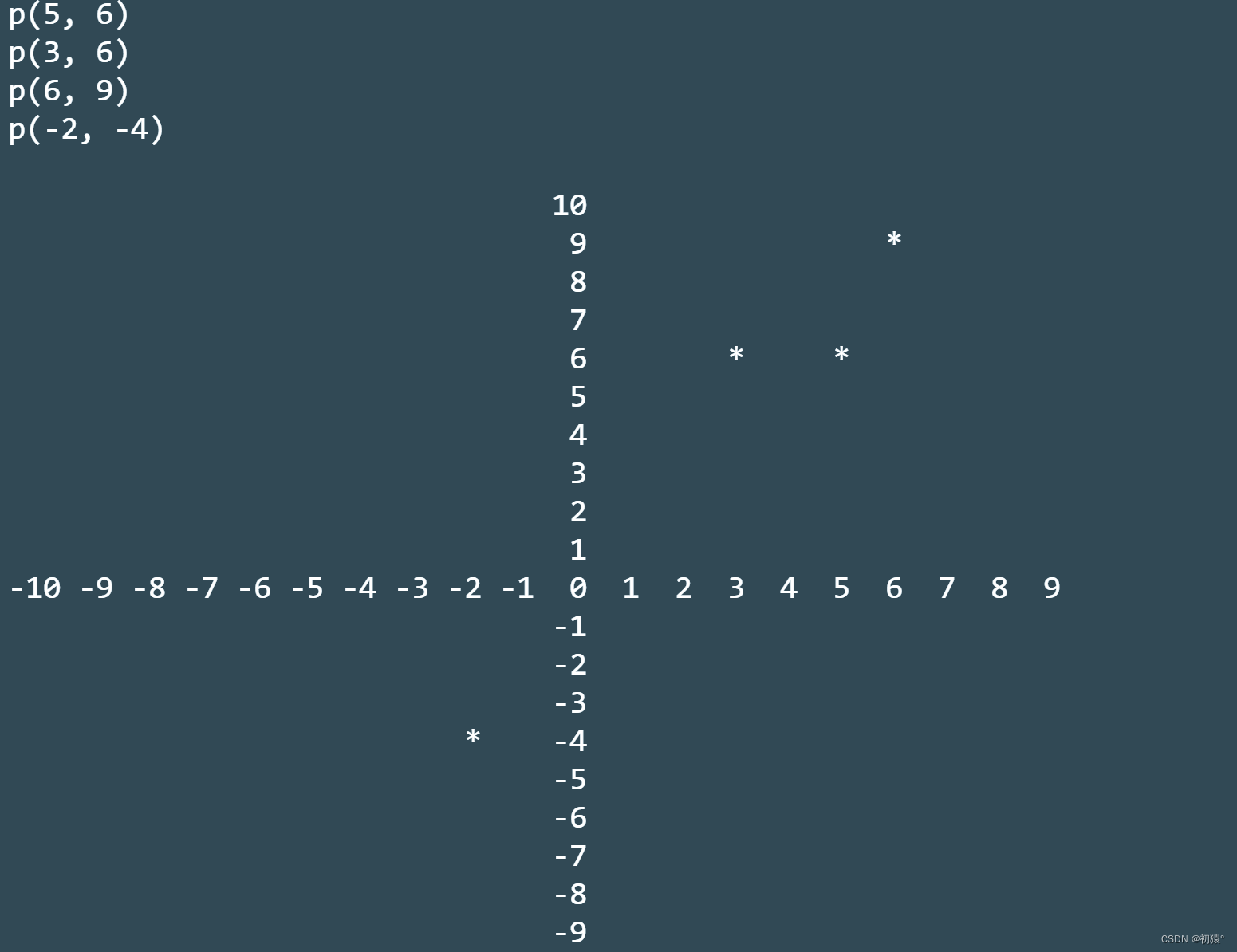

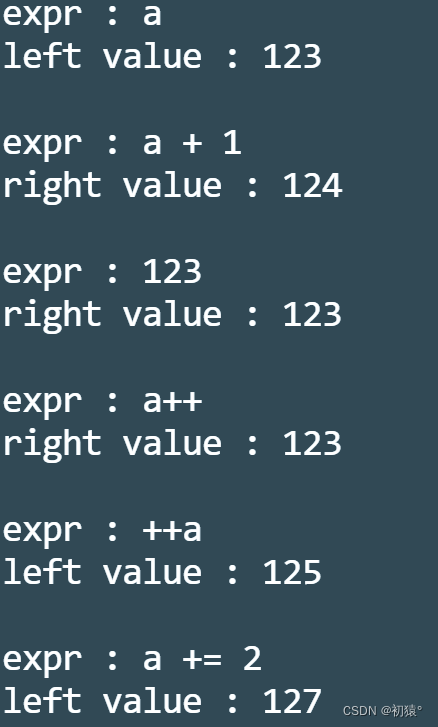







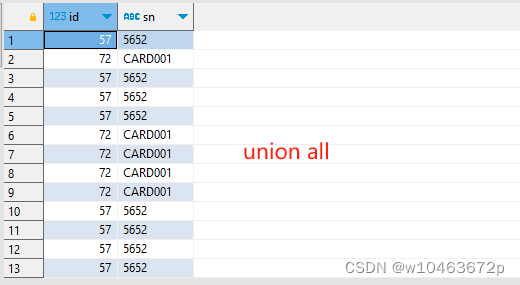
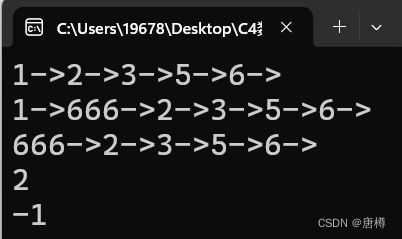

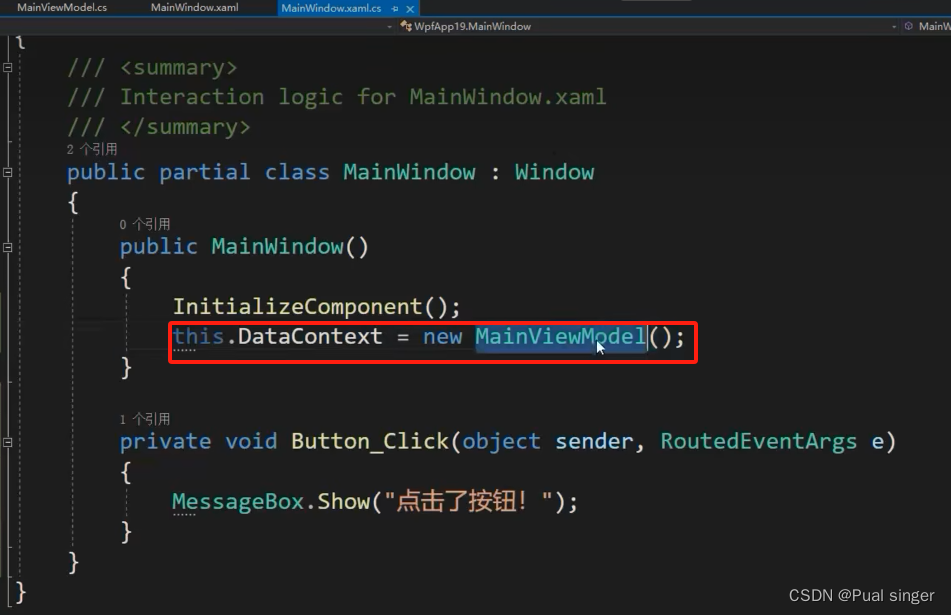

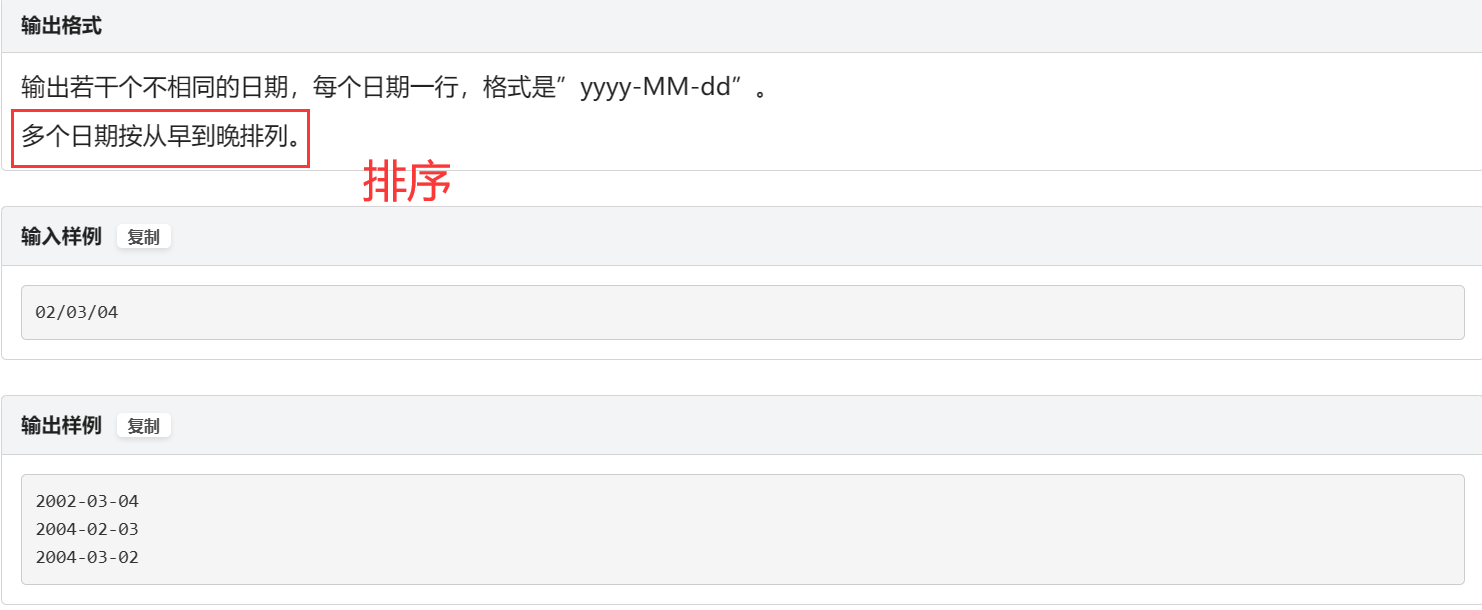
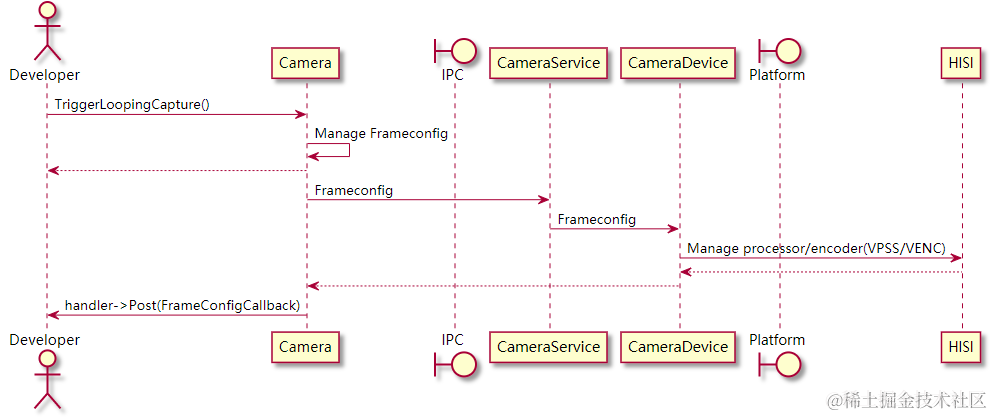

![AI论文速读 |2024[TPAMI]【综述】自监督学习在时间序列分析的分类、进展与展望](https://img-blog.csdnimg.cn/direct/298821f3e9e84d95bc42cb4a680b52e7.jpeg#pic_center)
